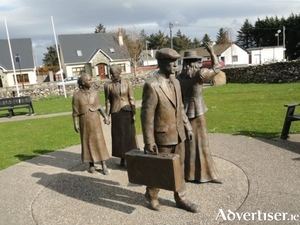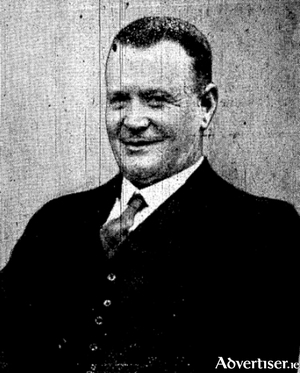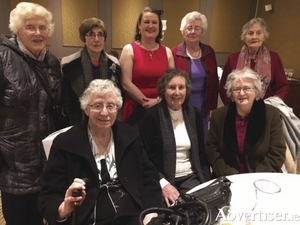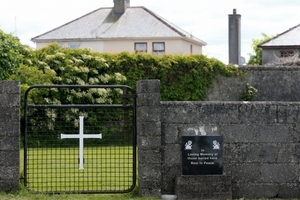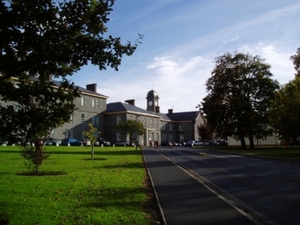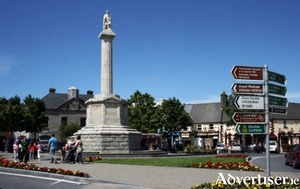The Mayo member and the maid
Fri, Apr 21, 2017
John Deasy was on one of his regular trips to London. While carrying out his duties as the member of parliament for the constituency of Mayo West, Deasy was a frequent lodger at Mrs Postlethwaite’s boarding house at 75 Warwick Street, Pimlico, where he occupied a back room on the top floor. After a busy weekend, the tired 37-year-old MP returned to his room on the evening of Sunday, 4 June, 1893. One candle burned on the table by his bed, emitting limited light. It being a late hour, Deasy rang the service bell in order to request his supper. He walked on to the landing to meet his familiar servant girl, Ellen Lewis. Lewis was a girl of 16 years of age and by his own account, Deasy had always considered her a virtuous and modest girl. But, whether through boredom or through more corrupt thoughts, Lewis’ angelical qualities had not prevented the married Deasy from flirting with the young maid during previous stays.
Read more ...Congreve’s Balsamic Elixir will cure what ails you
Fri, Apr 14, 2017
If you are of a certain age you will no doubt still be able to rhyme off several natural remedies from your childhood. I recall the use of mud to ease aching feet, and of course the use of a dock leaf on a nettle sting. Although, whatever properties were in the leaf we negated by our vigorous rubbing on the wound that probably created an aggravation far worse than the initial sting.
Those remedies were largely unnecessary and were applied mainly as part of childhood play. But there was a time when local folk medicine was the only accessible cure. Traditionally, the absence of medical knowledge and medical means necessitated a close observation of the natural world. Nature’s complex balances were noticed by early humans and from that a dependence on natural flora and fauna extracted remedies existed. Each Mayo area had its own variation of a widely known cure for the most common physical and mental complaints. Herbs mixed with butter and goose grease were identified in the Louisburgh area as being cures for running sores, boils, and erysipelas (skin infection). The district of Cross had its own cure for skin infection. Nettle juice taken about three times during the month of March was said to be a defence against all skin diseases for the year. Toothache was cured by smoking a clay pipe of tobacco, and for a swelling from a toothache in the face they would pull some chickenweed and apply to the inflammation as a dressing. Chickenweed is still used for its cooling effect. In some cases the remedies grew in time to become part ritual and were often fused with each locality’s Christian practices and became accepted locally as magic. A sprain was treated in Belcarra by the local weaver who would supply the injured with wool thread from his loom. The thread would be tied around the hurt limb and all would be fixed. The weaver enjoyed quite a reputation as a fixer and pieces of his thread would often be sent to England for boys from the district.
Read more ...RMS Titanic outcome was bigger than we think
Fri, Apr 14, 2017
In 1912, the county of Mayo had been through seven challenging decades of continuous population decline. The reasons for such a plummet in numbers were multiple. High infant mortality, disease brought on by poor diet, a demanding lifestyle, and high emigration tested the people of Mayo’s strength to the limit.
Read more ...Congreve’s Balsamic Elixir will cure what ails you
Fri, Apr 07, 2017
If you are of a certain age you will no doubt still be able to rhyme off several natural remedies from your childhood. I recall the use of mud to ease aching feet, and of course the use of a dock leaf on a nettle sting. Although, whatever properties were in the leaf we negated by our vigorous rubbing on the wound that probably created an aggravation far worse than the initial sting.
Those remedies were largely unnecessary and were applied mainly as part of childhood play. But there was a time when local folk medicine was the only accessible cure. Traditionally, the absence of medical knowledge and medical means necessitated a close observation of the natural world. Nature’s complex balances were noticed by early humans and from that a dependence on natural flora and fauna extracted remedies existed. Each Mayo area had its own variation of a widely known cure for the most common physical and mental complaints. Herbs mixed with butter and goose grease were identified in the Louisburgh area as being cures for running sores, boils, and erysipelas (skin infection). The district of Cross had its own cure for skin infection. Nettle juice taken about three times during the month of March was said to be a defence against all skin diseases for the year. Toothache was cured by smoking a clay pipe of tobacco, and for a swelling from a toothache in the face they would pull some chickenweed and apply to the inflammation as a dressing. Chickenweed is still used for its cooling effect. In some cases the remedies grew in time to become part ritual and were often fused with each locality’s Christian practices and became accepted locally as magic. A sprain was treated in Belcarra by the local weaver who would supply the injured with wool thread from his loom. The thread would be tied around the hurt limb and all would be fixed. The weaver enjoyed quite a reputation as a fixer and pieces of his thread would often be sent to England for boys from the district.
Read more ...Preparing for the invasion of Mayo
Fri, Mar 31, 2017
"People in the country in a position to know have stated that a national emergency may arise any moment, and an attack on the country may be imminent", so warned MJ Egan, County Commissioner for Mayo at a public meeting in Ballyhaunis in August 1940. An official state of emergency had already been in place since being proclaimed in the Dáil on September 2 1939, the day after Nazi Germany invaded Poland. Egan was principally Mayo County Secretary, but as County Commissioner his role was to create a network of parish councils that would maintain services in the event of an invasion and the possible incapacitation of central government. The Ballyhaunis meeting created its own council, bringing the figure to over 100 councils formed in 76 Mayo parishes. Since the fall of France to the Nazis in mid-1940, Britain was forced to tighten its own rationing programme. This had knock-on effects for Ireland. A key function of the parish councils would be the securing and distribution of food in a post-invasion scenario. Egan reported to, and received instruction from the new Department of Supplies under Minister Seán Lemass. It was through Egan as County Commissioner that a series of emergency precautions and directions were issued to the Mayo public.
Read more ...The practical patriotism of the ICA
Fri, Mar 31, 2017
I was fortunate to have been invited this week to give a talk on the history of Castlebar to the local branch of the Irish Countrywomen's Association (ICA). The evening went well, and my thanks to Maura McGuinness, Patricia Larkin, and all the membership for their hospitality. It was in preparing for that talk to an all-female audience that I was reminded of how devoid our local history is of women and women's groups, when compared to their male counterparts. In the 400 years I covered, only five women featured publicly and briefly. We know the reason for this was because a male dominated society had structured a degraded role for women which was almost impossible to break from. For those women who wanted to express themselves, the ICA was and remains an important outlet since its inception in 1910.
Read more ...Temperance, teanga and throw-ins
Thu, Mar 16, 2017
Though a feast day on the Catholic calendar since the 1600s, St. Patrick's Day only became a public holiday in Ireland in 1903. Prior to the early 20th century and a structured national approach to honouring the saint, the Briton was resurrected from time to time and pushed to the front of many campaigns. The feast day's events, which drew large crowds, were always managed either directly, or were heavily influenced, by the local Catholic church. That is not surprising, Patrick was a Christian after all. Many pre-Famine St Patrick's Day events were organised by the temperance movement, headed by Fr Theobald Mathew. The movement encouraged the Irish nation to pledge to abstain from alcohol for corporal and spiritual betterment, but sometimes with mixed results. The St Patrick's Day teetotallers procession through Castlebar in 1841 was not one of that organisation's high points. The march was to be a show of strength, an opportunity for the Rev Gibbons to display his and his members' accomplishments. Frustratingly for Gibbons, a large number of the group arrived to take up their places in the parade’s ranks while under the influence, having soundly violated their pledges. The non-teetotaller band abandoned the depleted parade midway through to join the town’s festivities, causing the temperance leaders to consider organising a teetotal band of their own that they could depend on.
Read more ...Mayo's Bon Secours inmates
Fri, Mar 10, 2017
In a little under five years time, Ireland will roll out the red commemoration carpets for a year long celebration to mark the centenary of the Irish Free State. In the decades preceding the independent state, unionist politicians and their constituents vigorously, and even militantly, opposed any form of self-determination for Ireland as they believed Home Rule under a Catholic majority would mean Rome rule. The fears of those unionists were realised. The Free State, like the British state before it, inadequately supervised Catholic institutions tasked with caring for sections of Irish society and thereby put at risk the very children of the nation that independence was destined to cherish. The Free State's successors were equally culpable of neglect as each fed its own citizens to an ultra conservative, practically unregulated, system of 250 Church-run industrial schools, reformatories, orphanages, hostels and homes from the 1920s up until the 1990s. Since the 1990s, criminal cases and inquiries have established that thousands of children were abused by hundreds of priests and several Catholic religious orders were found to have participated in or concealed child abuse.
Read more ...GMIT history can teach us valuable lessons
Fri, Mar 03, 2017
Why should we study history? Well, frankly, history is the study of human nature, and history most definitely repeats itself. History can teach us lessons so that we are forearmed when facing situations, better informed when planning to proceed. The history of the long campaign to establish the Regional Technical College (RTC, now the Galway Mayo Institute of Technology, GMIT) campus in Mayo contains, I believe, guidance on how the Castlebar based college can be rescued from those who oppose its survival.
Read more ...Two hundred and fifty year old Westport shows no signs of aging
Fri, Feb 24, 2017
Westport’s epic All-Ireland Intermediate final win last Sunday has come at the start of what is set to be an exciting year for the town. The westerners made history in the capital by becoming the first Mayo side to take the Intermediate title. While the people of Westport relocated from Croagh Patrick to Croke Park for a few nervous hours, they returned late Sunday night to a town that is planning to mark its own historic milestone. On March 17 1767, John Browne, Baron Mount Eagle, placed a notice in Faulkner’s Journal announcing his ambitious vision. "A New Town is immediately to be built near the Old Town of Westport in the County of Mayo, according to Plans and Elevations & already fixed upon, consisting of a large and elegant Market house, situated in the centre of an Octagon area of 200 feet, and to be enclosed with Twelve large well finished slated Houses, together with three avenues for Streets of thirty slated Houses, and several very large Streets for [a] great number of thatched Houses and Cabins," so read part of Browne’s announcement.
Read more ...The Inishkea seal slaughter
Fri, Feb 17, 2017
In October 1981, the carcases of 140 butchered seals were discovered on the Inishkea Islands, off the Belmullet peninsula. The slaughter horrified the public and animal welfare groups and the brutal manner in which the animals met their doom had ensured that the incident would gather negative media attention for the Erris area. But who carried out the massacre and why? The finger of blame immediately pointed to local fishermen.
Read more ...The Quiet Man who caused quite a racket
Fri, Feb 10, 2017
In terms of professional recognition and box office takings, the 1952 film The Quiet Man was a big success, the romantic comedy-drama was a gamble for Irish American director John Ford who was, until then, known largely for his high octane Westerns. The gamble paid off and Ford scooped his fourth Best Director Oscar for The Quiet Man. Though the film's stars John Wayne and Maureen O'Hara did not receive nominations, the film was nominated for seven awards and eventually won two at the 1953 Academy Awards. Its success was good news for Ireland, especially along the Mayo-Galway border, and the village of Cong in particular, where the film had been shot. Ford and his Hollywood entourage arrived in the west in the summer of 1951 to begin recording the film's outdoors scenes. The production had brought welcome employment to the area and the end result showcased the beauty of the region to a global audience.
Read more ...
